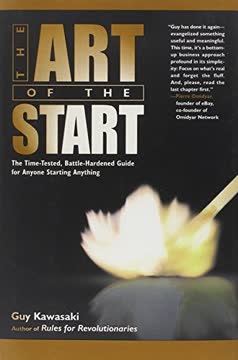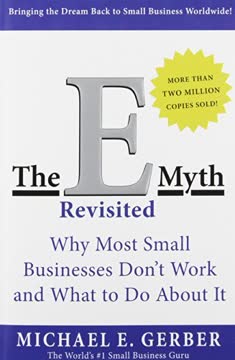Key Takeaways
1. Embrace the E-Myth: Businesses fail when technicians become reluctant entrepreneurs
The E-Myth says that most businesses fail because they are not founded by entrepreneurs, but by technicians, suffering from "an entrepreneurial seizure."
The E-Myth explained. The Entrepreneurial Myth (E-Myth) is the mistaken belief that people who are experts in a technical field will naturally succeed in running a business in that field. This leads to the phenomenon of "technicians suffering from an entrepreneurial seizure" – skilled professionals who start businesses without understanding the complexities of entrepreneurship.
Consequences of the E-Myth:
- Technicians focus on working in the business rather than on it
- Lack of strategic planning and systems development
- Overwhelm and burnout as the owner tries to do everything
- Stunted business growth and potential failure
Overcoming the E-Myth requires a shift in mindset from being a technician to becoming a true entrepreneur. This involves developing business acumen, creating systems, and learning to work on the business strategically rather than just performing technical work.
2. Develop an entrepreneurial perspective: Work on your business, not just in it
The technician goes to work in his business. The entrepreneur goes to work on his business.
Shift your focus. The key difference between a technician and an entrepreneur is where they direct their energy. A technician is consumed with doing the technical work, while an entrepreneur focuses on developing the business as a whole.
Working on your business involves:
- Creating systems and processes that allow the business to run without your constant involvement
- Developing a strategic vision for growth and expansion
- Building a team and delegating responsibilities
- Continually innovating and improving your business model
Benefits of this approach:
- Scalability: The business can grow beyond your personal capacity to do the work
- Freedom: You're not tied to daily operations and can focus on strategic decisions
- Value creation: A systematized business is more valuable and easier to sell or scale
3. Harness passion, purpose, and practice to fuel your entrepreneurial journey
Passion is what moves her. Because she allows it.
Understand true passion. Entrepreneurial passion is not just excitement or enthusiasm, but a deep-seated drive that fuels perseverance and creativity. It's the force that keeps you moving forward despite obstacles and setbacks.
Components of entrepreneurial success:
- Passion: The emotional energy and drive to pursue your vision
- Purpose: A clear understanding of why you're building your business
- Practice: The consistent application of skills and knowledge to improve and grow
Balancing passion and purpose: While passion provides the energy, purpose gives direction. Without purpose, passion can lead to unfocused efforts. Without passion, purpose can feel dry and uninspiring. The combination of both, coupled with consistent practice, creates a powerful formula for entrepreneurial success.
4. Master the discipline of enterprise leadership to shape your company's future
The discipline of perseverance is required to see the process of marketing development through to the very end.
Develop leadership skills. Enterprise leadership is about guiding your company towards its vision while managing day-to-day operations. It requires a balance of strategic thinking and practical execution.
Key aspects of enterprise leadership:
- Concentration: Ability to focus on critical tasks and priorities
- Discrimination: Skill to choose between alternatives and make decisions
- Organization: Talent for structuring work and resources effectively
- Innovation: Capacity to generate and implement new ideas
Balancing vision and execution: As an enterprise leader, you must simultaneously hold the big picture vision while attending to the details of implementation. This dual focus allows you to steer your company towards long-term goals while ensuring short-term success.
5. Implement strategic marketing to position your business as a unique brand
Positioning is the customer's general perception of your business and its products/services. Positioning takes place in the mind.
Create a unique market position. Effective marketing is not just about promoting products, but about creating a distinct place in the customer's mind for your business and offerings.
Elements of strategic marketing:
- Identify your target market and their needs
- Develop a unique selling proposition (USP)
- Create a consistent brand image and message
- Design a marketing mix that reaches and resonates with your audience
Differentiation is key: In a crowded marketplace, standing out is crucial. Your positioning should highlight what makes your business unique and why customers should choose you over competitors. This differentiation should be reflected in every aspect of your business, from product design to customer service.
6. Cultivate financial leadership to maximize cash flow and business value
Cash is the lifeblood of your business.
Master financial management. Financial leadership goes beyond basic accounting. It's about understanding and optimizing the flow of money through your business to maximize value and ensure sustainability.
Key areas of financial leadership:
- Cash flow management: Ensuring sufficient liquidity for operations and growth
- Profit optimization: Maximizing returns on business activities
- Financial planning: Projecting future needs and opportunities
- Risk management: Identifying and mitigating financial risks
The power of financial awareness: By developing a deep understanding of your business's financial dynamics, you can make informed decisions that drive growth and profitability. This includes knowing when to invest, when to cut costs, and how to price your products or services for maximum value.
7. Create a high-performance environment through effective management
A high-performance organization actually relishes change the way the driver of a high-performance car relishes a hill because it's an opportunity to let out the throttle and see what the machine can really do.
Foster a culture of excellence. A high-performance environment is one where employees are engaged, motivated, and consistently delivering outstanding results.
Elements of a high-performance environment:
- Clear goals and expectations
- Continuous learning and development
- Regular feedback and recognition
- Empowerment and autonomy
- Alignment of individual and organizational objectives
Embrace change: In a high-performance culture, change is seen as an opportunity for growth and improvement rather than a threat. This mindset allows the organization to adapt quickly to market shifts and stay ahead of the competition.
8. Design a client fulfillment system that converts customers into loyal clients
Client fulfillment consists of the product itself plus three major processes—production, delivery, and customer service—the combined result of which is to put your product or service into the hands of satisfied customers.
Focus on customer satisfaction. Client fulfillment is about creating a seamless, positive experience for your customers from their first interaction with your business through long-term relationship building.
Components of an effective client fulfillment system:
- Production: Creating high-quality products or services
- Delivery: Ensuring timely and efficient distribution
- Customer service: Providing exceptional support and problem resolution
- Follow-up: Maintaining ongoing communication and relationship building
Measure and improve: Use key performance indicators (KPIs) like Customer Conversion Quotient, Client Retention Quotient, and Client Multiplier Quotient to assess and continually improve your client fulfillment system.
9. Innovate and improve your business systems continuously
Every system can be improved.
Embrace continuous improvement. The most successful businesses are those that consistently refine and optimize their systems and processes.
Steps in the systems innovation process:
- Select a system for innovation
- Observe and analyze the current system
- Identify areas for improvement
- Implement changes
- Measure results and adjust as needed
Benefits of systems innovation:
- Increased efficiency and productivity
- Improved quality and consistency
- Enhanced customer satisfaction
- Greater scalability and adaptability
10. Master lead conversion to transform prospects into paying customers
Client fulfillment is not an easy task. Customers can be fickle and they're not always going to tell you when and why they're unhappy.
Optimize your sales process. Lead conversion is the critical process of turning interested prospects into paying customers. It requires a well-designed system and skilled execution.
Key elements of effective lead conversion:
- Clear understanding of your target customer's needs and motivations
- Well-defined sales process with specific steps and benchmarks
- Skilled sales team trained in consultative selling techniques
- Effective follow-up and nurturing systems
- Continuous testing and optimization of conversion strategies
Focus on value: The most successful lead conversion processes focus on demonstrating clear value to the prospect. This involves understanding their specific needs and showing how your product or service can meet those needs better than any alternative.
Last updated:
FAQ
What's E-Myth Mastery about?
- Entrepreneurial Focus: E-Myth Mastery by Michael E. Gerber emphasizes the importance of understanding the entrepreneurial mindset and transforming a small business into a world-class company.
- Seven Disciplines: The book outlines seven essential disciplines: leadership, marketing, finance, management, client fulfillment, lead conversion, and lead generation.
- Personal Growth: Gerber stresses the importance of personal growth and self-awareness for entrepreneurs, encouraging them to engage deeply with their passions.
Why should I read E-Myth Mastery?
- Transform Your Business: The book provides tools and insights to elevate your business from ordinary to extraordinary through structured practices.
- Learn from Experiences: It includes real-life examples and stories, making the lessons relatable and actionable.
- Develop Leadership Skills: Focuses on essential leadership skills necessary for effective communication and team inspiration.
What are the key takeaways of E-Myth Mastery?
- Entrepreneur vs. Technician: Distinguishes between being an entrepreneur and a technician, highlighting the need for an entrepreneurial mindset.
- Importance of Systems: Emphasizes the need for systems in business operations to achieve vision and consistency.
- Continuous Improvement: Advocates for a culture of continuous improvement, requiring innovation and adaptation.
What are the best quotes from E-Myth Mastery and what do they mean?
- “A business is a business is a business.”: Highlights the universality of business principles across industries.
- “The entrepreneur is nothing if not passionate.”: Emphasizes passion as a driving force in overcoming challenges and pursuing vision.
- “To build a World Class Company, you have to become a World Class Entrepreneur.”: Stresses the link between personal development and business success.
What are the seven essential disciplines outlined in E-Myth Mastery?
- Enterprise Leadership: Focuses on creating a business plan aligned with the entrepreneur's vision.
- Marketing Leadership: Involves understanding the target market and creating a unique brand identity.
- Financial Leadership: Covers financial strategies and management practices for sustainability.
- Management Leadership: Focuses on creating a high-performance environment through effective management.
- Client Fulfillment, Lead Conversion, and Lead Generation: Ensures client needs are met, leads are converted, and potential customers are attracted.
How does E-Myth Mastery define the role of an entrepreneur?
- Creator of Value: Entrepreneurs bring ideas to life, emphasizing creativity.
- Leader and Visionary: Must inspire and guide others to turn vision into reality.
- Continuous Learner: Committed to personal growth and adapting to new challenges.
What is the significance of passion in E-Myth Mastery?
- Driving Force: Passion is crucial for entrepreneurial success and overcoming challenges.
- Connection to Purpose: Passion must align with a clear purpose to maintain motivation.
- Source of Innovation: Passion fuels creativity and risk-taking, leading to breakthroughs.
How can I apply the concepts from E-Myth Mastery to my business?
- Implement Systems: Create systems for consistency and efficiency in business operations.
- Focus on Leadership Development: Cultivate essential leadership skills for effective guidance.
- Engage with Your Passion: Regularly reflect on your passion and its alignment with business goals.
What is the E-Myth point of view?
- Entrepreneurial Myth: Challenges the misconception that technical skills alone suffice for running a business.
- Importance of Perspective: Encourages a broader perspective on business as a system requiring strategic thinking.
- Focus on Personal Growth: Highlights the need for personal development alongside business growth.
What is the Central Demographic Model (CDM) in E-Myth Mastery?
- Definition: Describes the typical person in a market segment based on measurable characteristics.
- Importance in Marketing: Helps tailor products, services, and marketing messages to target customers.
- Application: Businesses use CDM to focus efforts on the most probable customers, enhancing marketing effectiveness.
What is the Central Psychographic Model (CPM) in E-Myth Mastery?
- Definition: Focuses on psychological characteristics like self-perceptions and emotional associations.
- Understanding Behavior: Provides insights into customer motivations and purchasing decisions.
- Integration with Marketing: Complements CDM for a comprehensive marketing strategy appealing to rational and emotional aspects.
How does E-Myth Mastery define client fulfillment?
- Comprehensive System: Encompasses production, delivery, and customer service as a complete system.
- Focus on Experience: Prioritizes the customer experience as paramount to business success.
- Long-term Relationships: Effective client fulfillment leads to lasting customer relationships, essential for sustainability.
Review Summary
E-Myth Mastery receives mixed reviews, with ratings ranging from 1 to 5 stars. Readers appreciate its detailed business advice and practical exercises but criticize its length and repetitive nature. Some find the narrative structure with Sarah's story distracting, while others enjoy the storytelling approach. The book is praised for its comprehensive coverage of business processes and entrepreneurial mindset, though some note its outdated internet marketing advice. Overall, it's considered valuable for small business owners, albeit requiring significant time and effort to implement its teachings.
Similar Books





Download PDF
Download EPUB
.epub digital book format is ideal for reading ebooks on phones, tablets, and e-readers.










